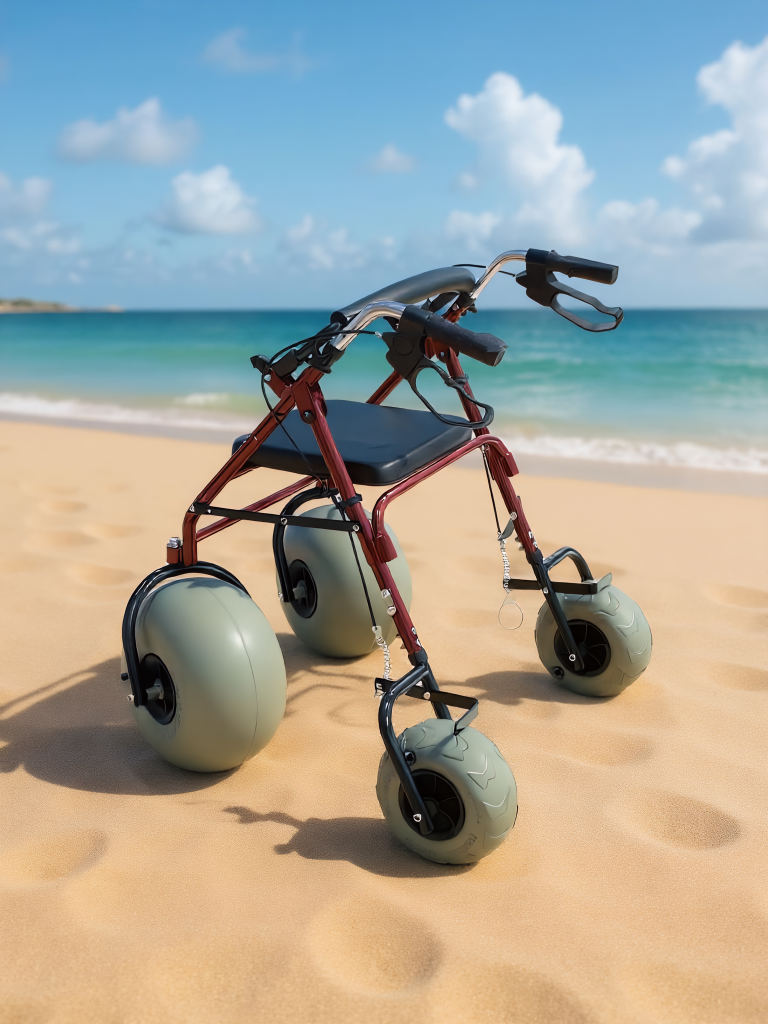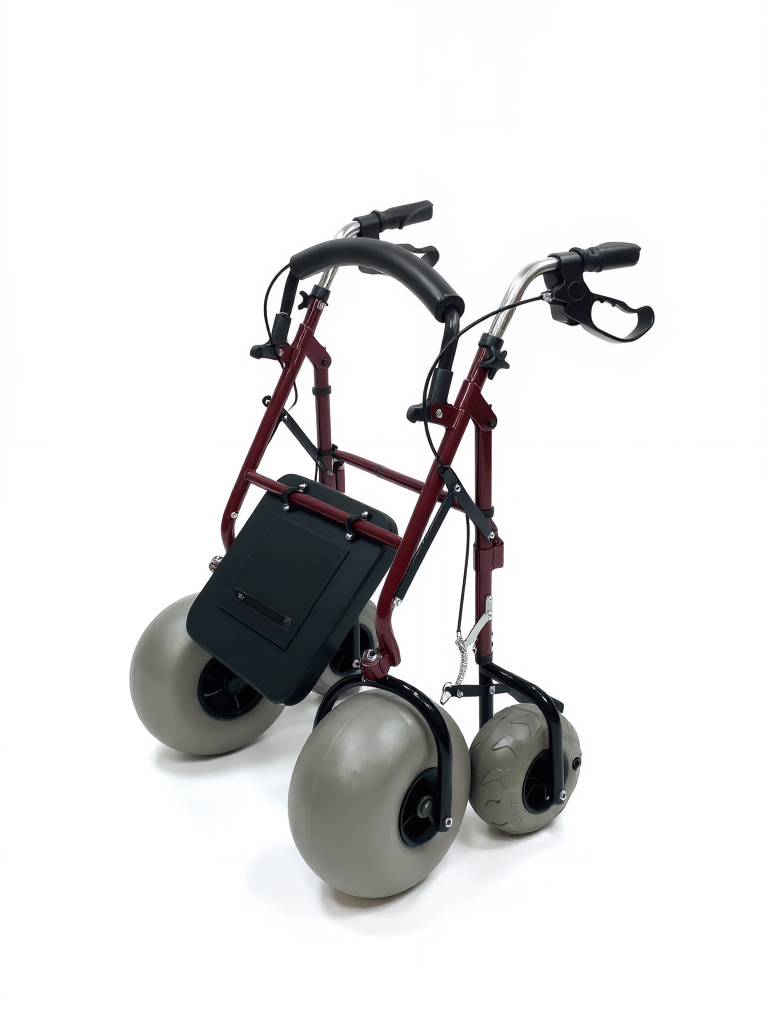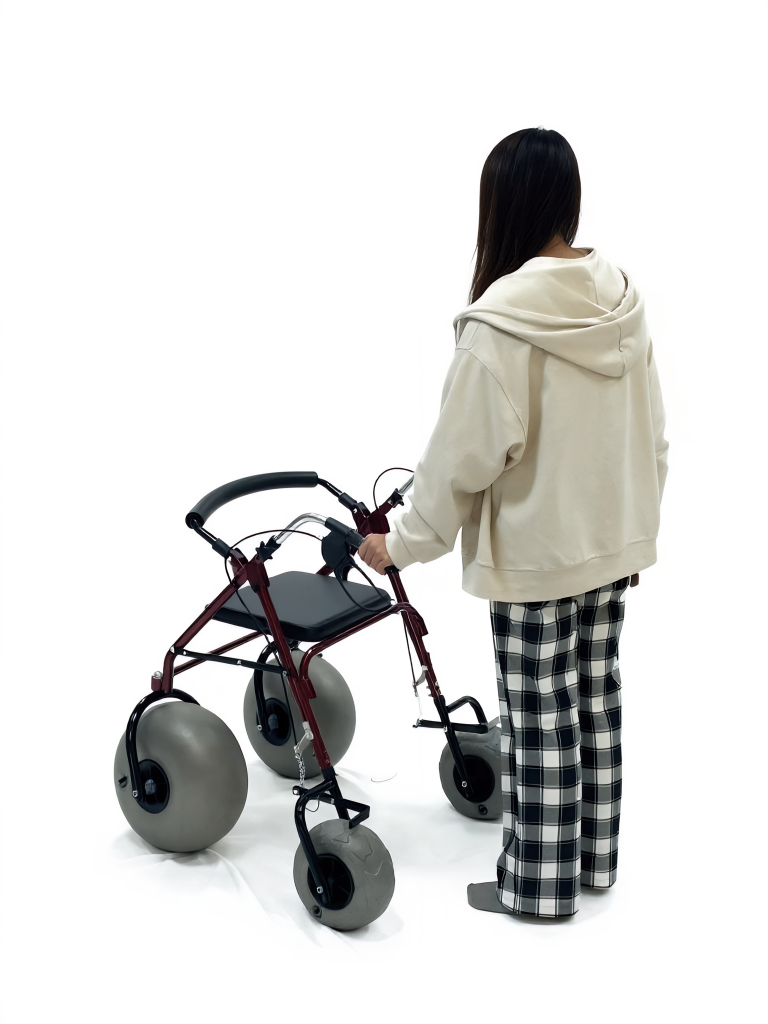
An Executive Summary for the Busy Procurement Manager
As a procurement manager, you balance two critical mandates: enhancing the guest experience while rigorously reducing long-term operational costs. This challenge becomes particularly acute with beachside accessibility equipment, where harsh conditions can quickly turn a poor investment into a significant liability. Standard walkers corrode, fail, and create a cycle of guest complaints and costly replacements, directly impacting your budget and your ability to protect the hotel brand’s reputation.
This guide eliminates the guesswork. We provide a definitive 5-point framework engineered for the commercial procurement of any commercial beach rollator. Move beyond superficial price comparisons to analyze what truly matters: saltwater corrosion resistance, verifiable safety compliance, and the total cost of ownership (TCO). This is your blueprint for making a strategic, defensible purchasing decision that elevates your guest accessibility solutions and delivers a measurable ROI for resort amenities for years to come.
The Hidden Costs of “Good Enough”: Why Standard Walkers Are a Liability on Your Property
Every seasoned procurement manager or resort operator has seen it: the well-intentioned purchase of a standard medical walker that quickly becomes one of the hidden costs of inferior equipment. The logic seems sound initially—”It’s just for occasional use.” But the unique, corrosive environment of a beach is a proving ground where “good enough” equipment consistently fails, creating a cascade of operational, financial, and hotel equipment liability headaches.
This isn’t just about a broken piece of equipment. It’s about the compounding business costs that follow.
From Guest Complaints to Maintenance Headaches: The Downward Spiral of Inadequate Equipment
The failure cycle of sub-par beach accessibility equipment is predictable and costly. It begins with the fundamental mismatch between the product’s design and its environment.
- Material Degradation: Standard walkers often use chromed steel or low-grade aluminum. Within weeks of exposure to salt spray, pitting and rust begin to form. Joints seize, finishes flake off, and the device becomes not only unsightly but structurally unsound. What was once an asset is now a rusty eyesore that detracts from your property’s premium image.
- Mechanical Failure: The beach is an engineering challenge. The narrow, hard wheels of a standard walker are designed for flat, indoor surfaces. In soft sand, they sink immediately, rendering the device useless and creating a strenuous, often dangerous, situation for the guest. This makes it a poor beachside mobility solution. Axles and bearings not sealed for sand and saltwater ingress quickly grind to a halt, requiring constant cleaning and eventual replacement.
- The Guest Experience Collision: Imagine a multi-generational family on vacation. A grandmother who needs beach mobility for seniors wants to join her family by the water. The equipment your hotel provides sinks into the sand after a few feet. What was meant to be an inclusive, joyful moment becomes one of embarrassment and frustration. This negative experience doesn’t just end on the beach; it ends up in a TripAdvisor review, impacting future bookings and undermining your efforts at enhancing the guest experience.
- The Operational Drain: For your maintenance team, these inadequate devices are a recurring nightmare. They spend valuable hours attempting to clean, lubricate, and repair equipment that was never designed for the conditions. This pulls them from other critical tasks and drains your maintenance budget. Soon, the cost of labor and replacement parts approaches the unit’s initial purchase price, leading to the inevitable conclusion: the walker is “beyond economic repair” and must be scrapped.
This cycle—from purchase to complaint to repair to scrap—is a core part of the equipment lifecycle cost. It’s a drain on your finances, your staff’s time, and, most importantly, your hotel’s reputation.

The 5-Point Framework for a Smarter Beach Rollator Investment
To break this costly cycle, a strategic shift in procurement is required as part of a larger strategic sourcing for hotels initiative. Instead of focusing solely on the initial acquisition cost, savvy managers evaluate potential equipment against a framework that prioritizes long-term value, safety, and guest satisfaction. This 5-point framework is your definitive guide to making a defensible, high-ROI decision.
Decision Point 1: Material Science — The Foundation of Durability and ROI
In a seaside environment, material selection isn’t just a feature; it is the single most important predictor of a product’s lifespan and, consequently, its total cost of ownership (TCO). The combination of salt, humidity, and abrasive sand creates a uniquely aggressive environment that mercilessly exposes any weakness in material quality, making the choice of durable outdoor guest equipment paramount.
Beyond “Stainless Steel”: Decoding Material Grades for True Saltwater and Corrosion Resistance
Many suppliers claim their products are “stainless,” but this term is often misleading. For a procurement professional, understanding the difference between grades is critical for ensuring genuine saltwater corrosion resistance.
- Grade 304 Stainless Steel: The most common type of stainless steel. While it offers good corrosion resistance in most environments, it is highly susceptible to “pitting corrosion” when exposed to chloride solutions—like saltwater.
- Grade 316L Stainless Steel: Often called “marine-grade” stainless steel, this alloy contains molybdenum, which dramatically increases its resistance to chlorides. For critical components like fasteners, axles, and brake mechanisms, 316L is the minimum acceptable standard.
An even better primary material is marine-grade aluminum for its non-corrosive frame construction. This material offers a superior combination of benefits:
- Excellent Corrosion Resistance: Naturally forms a protective oxide layer.
- High Strength-to-Weight Ratio: Allows for a robust, heavy-duty sand walker frame that remains lightweight.
- Aesthetics: Provides a durable, premium finish that won’t chip or flake.
Procurement Inquiry: When evaluating a supplier, ask for specifics. “Are your fasteners and brake components made from 316L stainless steel? What specific alloy and temper of marine-grade aluminum is used for the frame?” A knowledgeable supplier will have these answers readily available.
The Engineering Edge: Why Wheel Design and Frame Construction Matter
A beach rollator’s effectiveness comes down to two engineering realities: how it moves across sand and how it bears weight over time.
Wheel Design: This is a non-negotiable point. The ideal all-terrain mobility aid has specific wheel characteristics:
| Feature | Why It Matters | Red Flag to Avoid |
|---|---|---|
| Wide, Low-Pressure Profile | Distributes the load over a larger surface area, allowing it to “float” on top of the sand rather than digging in. | Narrow, high-pressure tires from standard walkers. |
| Puncture-Proof Polyurethane Wheels | Puncture-proof and durable. They won’t deflate, eliminating a major maintenance headache and creating low-maintenance resort amenities. | Pneumatic (air-filled) tires that can be punctured. |
| Sealed, Non-Corrosive Bearings | Prevents sand and saltwater from entering the hub, ensuring smooth rotation and preventing seizure. | Unsealed steel bearings that will rust and grind to a halt. |
Frame Construction: Look beyond materials to the quality of the build. Clean, consistent welds indicate higher manufacturing skill and a stronger, more durable frame. The geometry of the frame should also provide a low center of gravity for maximum stability on uneven terrain.

Decision Point 2: Compliance & Safety — Mitigating Procurement Risk
When you provide a guest with any equipment, you assume a degree of responsibility for their safety. For mobility devices, this responsibility is heightened. Verifying vendor compliance with internationally recognized standards is not a “nice-to-have”; it is a critical tool for mitigating procurement risk and a powerful indicator of a supplier’s commitment to quality.
What CE & ISO 13485 Certifications Actually Mean for Your Hotel’s Liability
These acronyms are clear signals of quality and safety that are essential for protecting hotel brand reputation.
- CE Marking: A CE certified medical device is a declaration by the manufacturer that the product meets essential EU health and safety standards. For a beach rollator, this means it has been assessed to be structurally sound and stable. Providing a non-CE-marked device could open your property to significant hotel equipment liability.
- ISO 13485:2016: This is arguably the more important certification. It is a quality management system standard for medical device manufacturers. An ISO 13485 supplier has proven to an independent auditor that they have robust, repeatable processes for design, production, and testing. This is one of the most important equipment quality control standards to seek.
Why this matters for you: An ISO 13485 certified supplier is less likely to have inconsistent production batches. It’s your single best assurance of consistent quality and a commitment to safety, which simplifies your hospitality supply chain management.
A Procurement Manager’s Checklist for Verifying Vendor Compliance
Do not take a supplier’s claims of certification at face value. Perform your own due diligence.
- Request the Documentation: Ask for a copy of the official CE Declaration of Conformity and the ISO 13485 certificate.
- Check the Certificate Details:
- Is the certificate issued to the actual manufacturer or a third-party trading company?
- Is the certificate still valid? Check the expiration date.
- Does the “scope” of the ISO certificate actually cover the design and manufacture of mobility aids?
- Verify with the Issuing Body: The certificate will name the Notified Body (for CE) or Registrar (for ISO) that issued it. A quick search can often verify its authenticity.
- Ask for Traceability Examples: Inquire about their process for batch tracking. A serious manufacturer can trace the specific components and quality checks for any given serial number.
Decision Point 3: Total Cost of Ownership (TCO) — Looking Past the Price Tag
The most common procurement mistake is confusing price with cost. The initial purchase price is only one component of the Total Cost of Ownership (TCO). A cheaper, lower-quality unit will almost always cost you more over its lifespan—a key insight revealed through proper equipment lifecycle cost analysis.
Calculating the True Equipment Cost: Factoring in Maintenance, Repairs, and Replacement Cycles
A simple TCO analysis, as part of your capital expenditure justification, can illuminate the long-term wisdom of investing in quality. Consider a 5-year outlook for a fleet of 5 beach rollators based on a standard equipment replacement cycle analysis:
| Cost Factor | Option A: Low-Price Unit ($300/unit) | Option B: Premium Unit ($800/unit) | Analysis |
|---|---|---|---|
| Initial Purchase (5 units) | $1,500 | $4,000 | The premium unit has a higher upfront cost. |
| Annual Maintenance | 100/unit/year=500/year | 20/unit/year=100/year | Premium units are low-maintenance resort amenities. |
| Expected Lifespan | 2 years | 7+ years | Lower quality materials fail quickly in a beach environment. |
| Replacement Cycle (5 Yrs) | Replaced twice (at year 2 & 4) | Replaced zero times | Frequent replacement cycles disrupt operations and budgets. |
| Total Replacement Cost | 2 cycles x 1,500=3,000 | $0 | This is a major hidden cost of the “cheaper” option. |
| Total 5-Year TCO | 1,500+(500×5) + 3,000=7,000 | 4,000+(100×5) + 0=4,500 | The premium option delivers $2,500 in direct savings over 5 years. |
This analysis of calculating true equipment cost doesn’t even include the indirect costs associated with Option A, such as negative guest reviews and brand damage. By shifting the focus to TCO, the more expensive initial purchase becomes the clear, fiscally responsible choice.
Decision Point 4: The Guest Experience — Turning Accessibility into a Competitive Advantage
In today’s experience-driven economy, providing genuine guest accessibility solutions is no longer a niche consideration; it’s a powerful market differentiator. Providing inclusive resort amenities and ensuring ADA compliant beach access can become a significant accessibility as a competitive advantage. This is a direct investment in guest satisfaction.
How Premium Accessibility Features Drive 5-Star Reviews and Repeat Bookings
When a guest can effortlessly transition to the sand and join their family, you have enabled a core memory. These are the experiences that translate into driving positive guest reviews and increasing repeat bookings.
- Emotional Impact: A high-quality commercial beach rollator with a comfortable seat and easy maneuverability transforms an accessibility challenge into a moment of inclusion. This emotional impact is what drives guests to write glowing reviews. They won’t just say, “The hotel was nice”; they will tell a story: “My mother was able to come down to the beach with us every day thanks to the amazing beach walkers the resort provided. It made our entire trip.”
- Word-of-Mouth and Social Proof: Happy families share photos. A picture of a grandparent smiling in a beach rollator, surrounded by grandchildren, is incredibly powerful user-generated content that showcases your property’s commitment to being family-friendly.
- Targeting a High-Value Market: The accessible travel market is a valuable and loyal demographic. By investing in superior equipment, you are directly appealing to this underserved market.
Features like a built-in storage bag, ergonomic handgrips, and reliable, easy-to-use brakes all contribute to an experience that feels thoughtful and premium, reinforcing your brand’s commitment to excellence.
Decision Point 5: Supplier Reliability — Choosing a Partner, Not Just a Vendor
For a commercial buyer procuring a fleet of equipment, the transaction doesn’t end at delivery. You need a reliable hospitality supplier. The reliability of your supplier is as important as the quality of the product itself. A weak link in the supply chain can lead to delays and inconsistent quality, undermining your entire investment.
The Strategic Advantage of Factory-Direct Equipment Sourcing
In global sourcing, you encounter two primary supplier types: pure trading companies and vertically integrated manufacturers.
- Trading Companies: These are middlemen. This model can lead to communication gaps, a lack of direct control over quality, and difficulty resolving issues.
- Vertically Integrated (Factory + Trade) Suppliers: This model combines manufacturing and direct exporting. This is the essence of factory-direct equipment sourcing.
The advantages of this integrated model are immense for a procurement manager:
- Direct Line to Production: Technical questions are answered by the source.
- Unwavering Quality Control: The company has full control over raw materials and processes.
- Supply Chain Stability: More reliable lead times and delivery dates.
- Accountability: A single point of contact and clear accountability.
Evaluating Production Capacity, Consistent Quality, and On-Time Delivery Guarantees
Before committing to a resort amenity fleet upgrade, vet your potential supplier’s operational capabilities.
- Production Capacity: Ask them directly: “What is your monthly production capacity for this model? What is your current lead time for an order of 20 units?”
- Quality Management: Inquire about their QC process. “Can you walk me through your quality checkpoints from raw material receiving to final assembly?” An ISO 13485-certified supplier can provide this.
- Track Record: Ask for case studies or references from similar clients. Their experience exporting to major markets demonstrates familiarity with international logistics and quality expectations.
Choosing a reliable, integrated supplier transforms the relationship into a strategic partnership, giving you the confidence that you will receive high-quality products on time, every time.
Case Study: How a Five-Star Resort Turned an Accessibility Problem into a Marketing Asset
The Challenge: Negative Guest Feedback on Beach Accessibility
A luxury resort on the Spanish coast faced a recurring issue. They were receiving an increasing number of comments mentioning the difficulty for older guests or those with mobility issues to enjoy the sand and sea. One particularly sharp review on TripAdvisor decried a “frustrating and exclusionary experience.” The General Manager knew this was a brand problem that contradicted their image of inclusive luxury.
The Solution: A Strategic Resort Amenity Fleet Upgrade
The procurement team was tasked with finding real beachside mobility solutions. Using a framework similar to the one outlined above, they initiated a resort amenity fleet upgrade, investing in a fleet of 10 premium, marine-grade beach rollators—a true all-terrain mobility aid—from a vertically integrated, ISO 13485-certified supplier.
The impact was immediate and measurable:
- Complaint Reduction: Within the first three months, guest complaints related to beach accessibility dropped to zero.
- Positive Review Surge: Over the following six months, the resort saw a 20% increase in TripAdvisor reviews that specifically mentioned “excellent accessibility,” “family-friendly,” and “thoughtful amenities.”
- New Marketing Angle: The marketing team leveraged this success, promoting beachside accessibility as a key luxury amenity. This attracted bookings from multi-generational travel groups, a high-value demographic.
The resort’s engineering head stated, “This investment paid for itself in six months, not just in reduced maintenance, but in the positive press we received. It solved a guest complaint and became a new reason for people to choose our property.”
Your Next Step: Making an Informed, Strategic Procurement Decision
Providing a flawless beach experience for all your guests begins with a smart procurement decision. Choosing a durable, compliant, and reliable product is a strategic investment that yields long-term returns. Making defensible purchasing decisions is key to success.
When you’re ready to elevate your property’s accessibility standards, take the next step.
Download the Full Technical Specification Sheet & Compliance Guide
Schedule a 15-Minute Consultation to Discuss Your Property’s Specific Needs
Let our specialists provide a complimentary TCO analysis for your property and answer your specific technical and logistical questions. [Click Here to Schedule Your Consultation]
